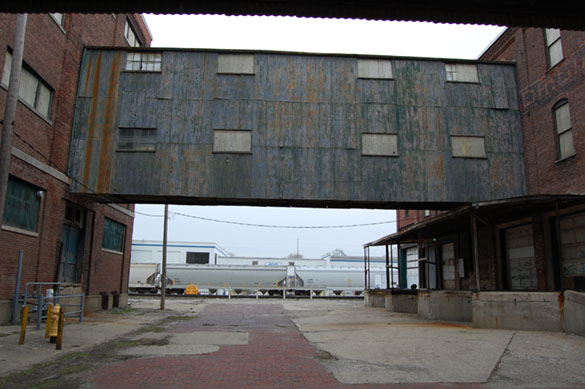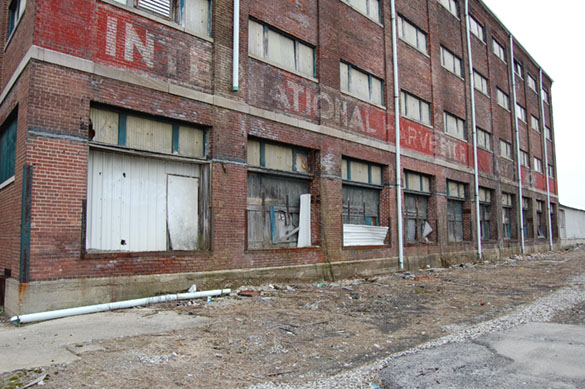Last week I discussed how one photo (above) inspired a simple P48 display that I could take to various RPM meets. With that in mind, here are a few specific criteria I’ve considered so far.
The most important question:
Where will this thing reside between shows? This simple reality is often ignored in the excitement of new project fever. But the answer to this question will drive everything because I’m at the stage where useless clutter is no longer tolerable. My wife and I have been cleaning out and paring down anything that is no longer of use to us and this includes my modeling accumulation which is long overdue for a good prioritizing.
These are non-negotiable
- A self-contained plug and play design. This includes scenery, the backdrop, lighting and control system. Two, possibly three sections are acceptable as they would include off-scene staging and display functions.
- A professional presentation, with signage, proper lighting and integrated display panels that educate and inform viewers. And, since OST Publications isn’t a charity, book display is a given too. Such panels would also draw attention away from the open staging areas. (Thank you to the designers of the Scalefour Society’s, South London Area Group’s, St. Merryn for this idea. If you have access to it, see Model Railway Journal No. 230, pages 109-111.)
- Designed with my future mobility issues in mind. Meaning lightweight. I’m now sixty. Does anyone think moving, set-up and breakdown are going to get easier in ten years, five or even one? Let’s deal with reality here.
- Everything has to fit in my vehicle. And I mean EVERYTHING: Susan and I, our luggage, a snack cooler, books for sale, the display, plus all the other road trip stuff.
The design criteria
The primary section could be up to 54 inches long and up to 28 inches in height and still fit in my car. I already planned on a modest width of 16 or maybe 18 inches at most. Since the length and height are odd dimensions and might not fit in a different vehicle in the future, I’ve decided to reduce the length to four feet and see where the warehouse building I plan to model comes to in terms of height. A module with those dimensions would fit in the back seat, leaving room for support material, luggage and the other paraphernalia in the cargo area behind. Or, everything could fit in the cargo area with room to spare if I lowered the rear seat backs.
At this stage, I picture the main section as a self-contained box with built-in LED lighting and a simple control system. Lightweight construction has been well documented here and abroad, so that’s a simple choice of going with my personal preference. Ease of use is the key. Anything else is a deal breaker.
Getting down to specifics
In the photo below, I’m looking at the track side of the warehouse on the left in my original photo. There were two sidings here back in the day and the ten loading doors could serve as individual car spots for switching. I can picture box cars lined up side-by-side with ramps from the building through the doors to reach those on the outer track.
What I’m looking at here is the suitability of using this facade as the entire backdrop for the scene. I’m thinking in terms of a flat that stretches the length of the module and using the height of the building as the determining factor for the module. The lack of depth in the flat will be disguised by the module’s ends and lighting cover. Yes, the wall is plain but the remnants of the painted sign, the pilasters and the depth of the loading door openings add visual interest and relief.
I’m thinking of the early 1960s for the era, specifically 1960-65, when this industry still had modest rail traffic. In that era the windows would not have been covered with the plastic sheeting and the loading doors would have been in better shape.
While there is potential in what I just outlined, it doesn’t really move me visually. Two tracks would crowd a small module quickly and truthfully, at only four feet in length, they would be boring. I do like the idea of using this warehouse as the backdrop and I want to give more thought to ways of capturing the qualities that drew me to the first photo.
Operational considerations
Keep in mind that my primary focus is on the presentation rather than operation. Still, it’s nice to show how well quarter-inch scale can strut its stuff and a track with multiple car spots fed by staging on one or maybe both ends is more than sufficient for my purposes. A single locomotive and a handful of cars also work in my favor toward simplicity.
No, something this basic won’t keep people entertained for long but neither does a mindless loop. And no, it won’t be to everyone’s liking but I’m not trying to satisfy every taste. Those who are intrigued will make themselves known and the conversation will go from there.
As things develop there will be tweaks and refinements. I know a project like this will generate all manner of ideas and suggestions. While I’m very clear about my intent, toss the ideas out there anyway. Maybe someone else will be inspired to do a project of their own. Next time I’ll unveil the plan.
Regards,
Mike


“No, something this basic won’t keep people entertained for long”
I respectfully disagree. Perhaps there’s a disconnect on the definition of “long”, but I’d say, at a “train show”, if I spent 15 minutes looking at something, that’s a serious commitment given all the other opportunities likely in the same or adjacent rooms.
Now, if in those 15 minutes, I was consumed with examining the detail and realism proffered by, as you might say “quarter-inch done well”, then I’d say you’ve accomplished something. Bonus points if I walked away (even if on my mobile device) with one of your books, too. 🙂
–Rich
The example of the micro ‘glimpse’ layout is a sound and well tried concept, certainly not unique. This scenario is, though, too much frame and not enough picture and the eye is not drawn to the ‘glimpse’, instead a better ratio of frame to moving image is needed irrespective of how much you might like industrial urban grunge.
Thanks Rich.
Tim,
As noted in the post title, this work is inspired by the Richmond photo, not a literal copy of it. I think you’ll see the proportions you’re looking for when I share the plan. And, please sign your comments next time.
Mike
Rich has a very good point. To draw a parallel, the BBC has a very good Arts Editor, Will Gompertz, who has a fascinating background story into how he got into the arts.
When still young, he visited an art exhibition with his then girlfriend (mostly to please her, rather than out of any real enthusiasm for the exhibition). He basically gave each item a cursory glance and little more. On the way out, his girlfriend asked him he what he thought about a particular piece, and he replied very non-committally along the lines of, “Not much”. This elicited an extreme reaction from her, so he went back to the exhibition and spent two hours looking at this one piece: from various angles, inspection the composition, the way it was executed: basically everything he could think of looking for and at.
There are those who will visit an exhibition to see trains running. And there are those who come to appreciate the modelling. The latter may be fewer in number, but they are also the sort of people who understand the difference between “fun” and “satisfaction”.
One question: have you thought about using forced perspective on the buildings, to take up less space and draw the eye in to the scene?
(And if you have a 4’ long module, you have a simple 2’ fold-down flap at each end acting as cassette decks.)
Simon